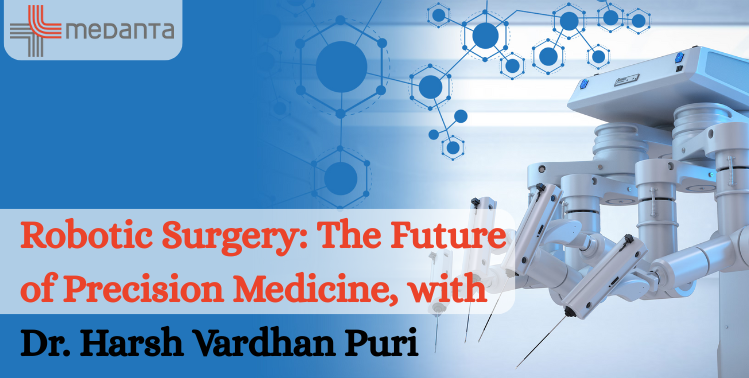CH Baktawar Singh Rd, Medicity, Islampur Colony, Sector 38, Gurugram, Haryana 122001

24 October, 2025
adminIn recent years, Robotic surgery has transformed how complex surgical procedures are performed. As minimally invasive techniques gain traction, robotic platforms are pushing the envelope of what is possible—allowing surgeons to operate with finer control, improved ergonomics, and better patient outcomes. Under the leadership of Dr. Harsh Vardhan Puri, patients now have access to world-class robotic surgical care, combining technological innovation with clinical excellence.
We’ll explore what robotic surgery means today, its advantages, challenges and future trends, and how Dr. Harsh Vardhan Puri is making a difference in this space.
Robotic surgery (often more accurately “robot-assisted surgery”) refers to surgical procedures performed using robotic systems, in which the surgeon controls mechanical arms and instruments via a console rather than directly manipulating tools by hand.
A typical robotic system has three core components:
Because the surgeon is in control of every motion, robotic systems are not autonomous—they are highly advanced “hands” that amplify human skill.
Robotic surgery offers a range of compelling benefits when compared to traditional open surgery or even conventional laparoscopic techniques:
Today, robotic surgery is used across a variety of specialties:
Because of the precision, robotic platforms are especially well-suited for surgeries in confined regions (pelvis, chest, retro peritoneum) or where critical structures (nerves, vessels) need preserving.
Under the stewardship of Dr. Harsh Vardhan Puri, his team offers robotic solutions in (you can insert his specialties: e.g. urology, gynecology, general surgery), ensuring that patients benefit from the most advanced surgical care available today.
While robotic surgery has many advantages, it is not without challenges:
Nevertheless, many of these limitations are being actively addressed through innovation, competition, and technology improvements.
The robotic surgery landscape is evolving rapidly. Here are some key trends shaping the future:
Smaller, modular robotic platforms will allow deployment in standard ORs, with reduced cost and more flexible designs.
AI-driven decision support, auto-segmentation of anatomy, real-time surgical guidance, and semi-autonomous tasks (e.g., suturing) will increasingly assist surgeons.
In fact, recent studies show that AI-assisted robotic surgeries exhibit a 25 % reduction in operative time and 30 % fewer intraoperative complications compared to manual techniques.
Fusion of preoperative CT/MRI data with intraoperative imaging (ultrasound, fluorescence, augmented reality overlays) will enhance precision and navigation.
Robotic systems controlled across distances—already demonstrated in transcontinental surgeries—open possibilities for expert care irrespective of geography.
One notable example: in July 2025, a gastric bypass was successfully performed via transcontinental robotic surgery between France and India, spanning over 8,500 km.
Research is underway to enable surgeons to “feel” tissues via force sensors, tactile feedback, or other haptic interfaces—a key leap in making robotic surgery more intuitive.
With expiration of certain patents, new competitive robotic systems are emerging (modular, flexible, lower cost) to challenge dominant systems.
As costs fall and modular systems proliferate, more hospitals—especially in emerging economies—will adopt robotic surgery techniques, improving equity in surgical care.
Given these surgical advances, what sets Dr. Harsh Vardhan Puri apart? Here are some compelling reasons for patients:
When evaluating any surgeon or center for robotic surgery, consider the following criteria:
Robotic surgery is no longer the stuff of futuristic speculation—it’s here, and it’s enhancing how complex surgeries are conducted across the globe. With precision, improved ergonomics, and faster recovery, robot-assisted procedures are reshaping patient expectations and surgical norms.
Under the leadership of Dr. Harsh Vardhan Puri, patients receive not just advanced technology, but compassionate and skilled care grounded in clinical safety and cutting-edge innovation. If you or a loved one is considering surgery in a domain where robotics may apply (urology, gynecology, general surgery, oncology, etc.), exploring a robotic surgical consultation with Dr. Puri can help you understand the specific benefits, risks, and suitability for your case.
Category : Robotic Surgery
Tags: Robotic Surgery